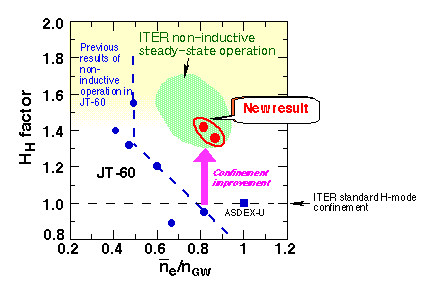Demonstration of Non-inductive Operation Scenario for ITER
In ITER, two operation scenarios have been considered with respect to the driving method of the plasma current; namely the inductive pulsed operation and the non-inductive steady-state operation. For non-inductive steady-state operation of Q = 5, higher confinement than the standard H-mode confinement (ITER scaling) is required at high-density regime.
JT-60 has been conducting researches on steady-state operation of tokamaks using the combined injection of neutral beams and RF waves into the reversed shear plasma with a high bootstrap current fraction.
Recently, a fully non-inductive current drive was successfully accomplished with high confinement (HH factor ~1.4) at high-density regime ( ~0.8) as shown in the figure below. This result was attributed to: (1) increase in the triangularity of plasma cross section δx from 0.3 to 0.4 to improve confinement at high-density regime, and (2) the newly developed technique for the fast and precise control of a distance between the RF antenna and plasma edge to keep good RF coupling.
~0.8) as shown in the figure below. This result was attributed to: (1) increase in the triangularity of plasma cross section δx from 0.3 to 0.4 to improve confinement at high-density regime, and (2) the newly developed technique for the fast and precise control of a distance between the RF antenna and plasma edge to keep good RF coupling.
This is a new result supporting the non-inductive steady-state operation scenario in ITER.

Fig. The ratio of line-averaged electron density  to the Greenwald density nGW and the confinement improvement factor (HH factor) in the condition of non-inductive full current drive. Confinement at the high-density regime is substantially improved. The HH factor of ~1.4 has been attained at the
to the Greenwald density nGW and the confinement improvement factor (HH factor) in the condition of non-inductive full current drive. Confinement at the high-density regime is substantially improved. The HH factor of ~1.4 has been attained at the  /nGW of ~0.8, where the plasma current Ip is 0.9 MA, the bootstrap current fraction fbs is 60~70%, the safety factor q95 is 6.8, and the normalized beta value βN is 2.2. This result supports the non-inductive steady-state operation scenario in ITER.
/nGW of ~0.8, where the plasma current Ip is 0.9 MA, the bootstrap current fraction fbs is 60~70%, the safety factor q95 is 6.8, and the normalized beta value βN is 2.2. This result supports the non-inductive steady-state operation scenario in ITER.
